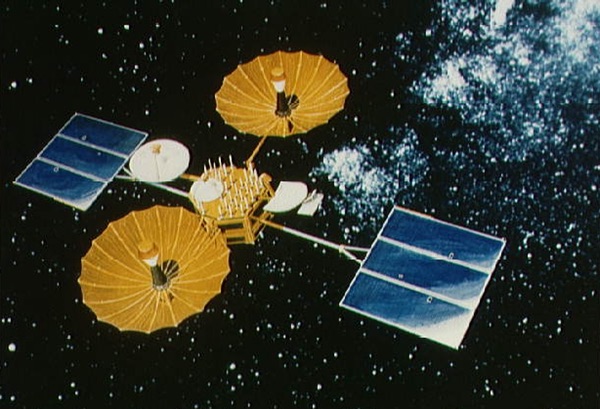Serendipity in the space program: TDRS-1, GEODSS, and one amazing phone callby Joseph T. Page II
|
| The system, as designed, would also exclude any coverage of high latitudes, including the polar regions. |
During the early years of the space program, NASA relied entirely upon ground tracking stations to maintain communication with satellites and manned spaceflight missions such as Mercury, Gemini, and Apollo. The NASA communications (NASCOM) network consisted of the Space Tracking and Data Acquisition Network (STADAN) and the Manned Space Flight Network (MSFN). A third portion, the Deep Space Network (DSN), was used primarily for interplanetary space probes. During early crewed flights, communications with NASCOM ground stations were averaging less than 15 minutes of connectivity per 90-minute orbit.1 The network worked well for infrequent flights, but a more robust solution was needed with the promise of more Space Shuttle missions in the 1980s.
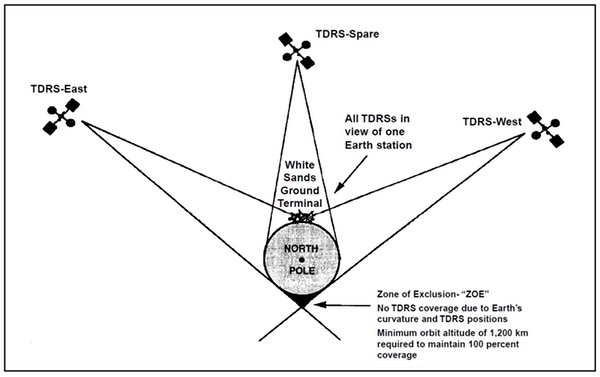 Design of the Tracking and Data Relay Satellite System. (credit: NASA) |
The answer was a space-based network of communication satellites. The brainchild of famed sci-fi writer Arthur C. Clarke, a geosynchronous orbit would allow a communications satellite to remain at the same portion of the sky as seen by ground observers with minor north-south (“figure eight”) drifting. By keeping the orbital inclination at zero, the satellite would remain at a fixed point in the sky, in a so-called geostationary orbit. The planned Tracking and Data Relay Satellite System (TDRSS, colloquially pronounced “tea dress”) would place two satellites—East and West—approximately 130 degrees apart, with a third spare satellite “parked” in between. The coverage provided by the East and West satellites would cover a good portion of the world, but would create a “zone of exclusion” on the far side, offering no coverage for spacecraft in low Earth orbit. The system, as designed, would also exclude any coverage of high latitudes, including the polar regions.
The sixth shuttle mission, launched on April 4, 1983, was selected for the first TDRS launch.
 Crew of STS-6, humorously dressed in “F-Troop” garb. (credit: NASA/Spacefacts.de) |
F-Troop and a fistful of “firsts”
The crew of STS-6 consisted of commander Paul Weitz, pilot Karol “Bo” Bobko, and mission specialists F. Story Musgrave and Don Peterson. Weitz had previously flown on Skylab 2 in 1973. Bobko and Peterson were ex-Manned Orbital Laboratory astronauts, while Musgrave was selected in the third NASA group—the three had waited approximately 17 years each for their first spaceflight. The mission was full of spaceflight “firsts”: the first flight of Challenger, first spacewalk during the shuttle era, and first deployment of a TDRS riding on the first firing of a shuttle-borne Inertial Upper Stage (IUS). (For a humorous look at the “F-Troop” moniker, see Ben Evans’ “30 Years Since STS-6: The Mission of the ‘Geritol Bunch’”).
| No response. It was as if the satellite was no longer there. |
Approximately eight hours into the mission, Musgrave and Peterson began running through the checklist to deploy TDRS-A (TDRS satellite designations change from alphabetic to numeric once they reach their intended orbit.)2 A spring-loaded ejection freed the TDRS/IUS stack from the cargo bay. About an hour later, after traveling clear of the shuttle, the first stage of the IUS was fired with no issues. Five hours after first stage shutdown, the IUS second stage was ignited. The burn progressed normally until around 85 seconds into a planned 105-second burn.
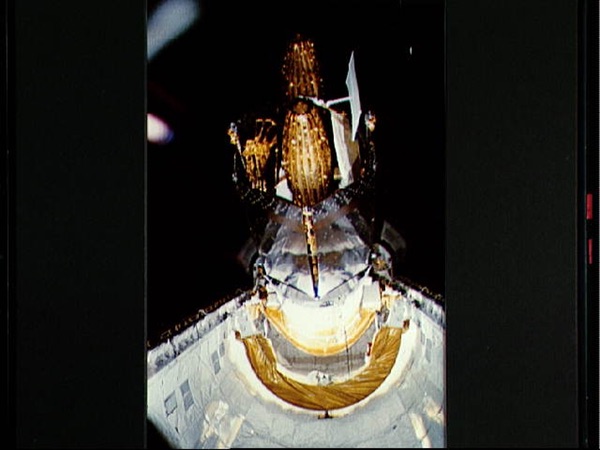 TDRS-A/IUS upper stage in Challenger’s cargo bay prior to deployment. (credit: NASA) |
According to a thermal assessment by Marshall Space Flight Center, the payload experienced a loss of control likely due to “failure of the thermal protection system” around the nozzle.3 The nozzle lost the ability to gimbal, and was stuck in a canted (off-axis) position. Since the stack was flying through areas of high cosmic radiation levels, signals to the satellite or upper stage were not received.
According to Glynn Lunney, the shuttle payload integration manager at the time: “We started [transmitting] separation commands ‘in the blind’…[We] jacked up the power on the network to as high as we could get. We never got any [confirmation] signal.”4
No response. It was as if the satellite was no longer there.
Operating Location AM
Due to forethought by MIT Lincoln Labs for an unrelated task, “someone” did see what was happening in orbit: the Ground-based Electro Optical Deep Space Surveillance (GEODSS) system in Socorro, New Mexico.
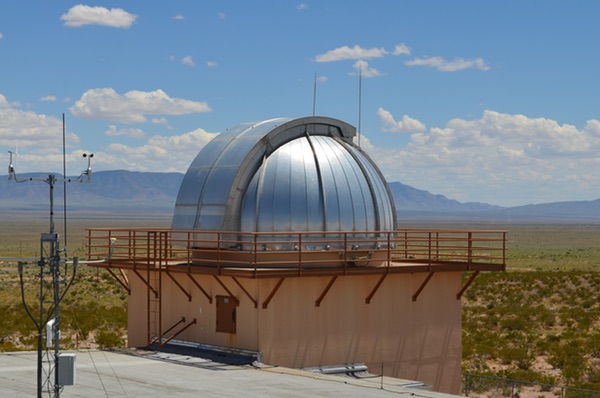 Telescope dome at the Socorro GEODSS site. (credit: USAF) |
The Socorro GEODSS site was activated as Detachment 1, 1st Strategic Aerospace Division, in April 1981. The system was not declared fully operational until July 30, 1982, nearly a year before STS-6. The electro-optical “eyes” of GEODSS supplement the radar-based space surveillance sensors around the world by observing deep-space objects “in the period range of 225 minutes and beyond using Charge Coupling Device (CCD) technology.”5 Co-located with Detachment 1 was the MIT Lincoln Labs Experimental Test Site (ETS), the testbed for “advanced electro-optical space surveillance technologies.”6
According to orbital debris expert Donald Kessler, GEODSS was tasked to investigate solid rocket burns in geosynchronous orbit:
In October, 1982, MIT video recorded an (non-Shuttle) IUS upper stage burn in geosynchronous orbit. The sunlight reflecting off the aluminum oxide exhaust from this burn was so dramatic that we asked MIT to observe the IUS burn associated with NASA’s TDRS-1 geosynchronous satellite on April 5, 1983. We had hoped to better understand the dispersion of the aluminum oxide dust from this observation. Instead, the telescopes recorded a failure in the mission. About halfway through the burn, a tumbling rocket and aluminum oxide plume was clearly visible, even though the sky was partially cloudy.7
The aphorism “a [GEODSS] picture is worth a thousand words,” gave confidence to NASA engineers to keep trying for separation in lieu of the lack of telemetry.
“Yeah, science!”
Realizing that scrapping the mission was not an option, orbital specialists at NASA determined a way to save the satellite: a series of small delta-V changes using it stationkeeping reaction control thrusters. The satellite had 24 of these thrusters, each providing about one pound of thrust from the hydrazine fuel aboard: a colloquial “mouse fart.”8
In his presentation “First-Hand Lessons Learned from Six Decades of Spacecraft Guidance and Control Experiences,” Henry C. Hoffman, Jr., details how TDRS limped to a geosynchronous orbit:
The north-south [station keeping] requirement went away before launch but the spacecraft was flown with a full fuel load, which was about 30 times of that required to make mission. This was fortunate because the extra fuel was more than enough to reach mission orbit in spite of the IUS failure. However, the only thrusters on board were one pound force thrusters and the spacecraft weighed about 5,000 pounds. We raised perigee about 8,600 miles with two one pound thrusters. It took about four months and 39 apogee burns, some as long as 180 minutes. It took a total burn time of 44 hours, consuming about 800 pounds of propellant, as well as an adaptable, robust and flexible ACS [attitude control system] design and much resourcefulness from ground operators to accomplish that recovery feat.
The lifespan of the TDRS satellite, as determined by its remaining fuel reserves, was severely limited. But it was alive.
Almost three months after launch, the final burn raised it to the correct orbital altitude. On July 1, 1983, the satellite received its hard-earned designation as “TDRS-1.”
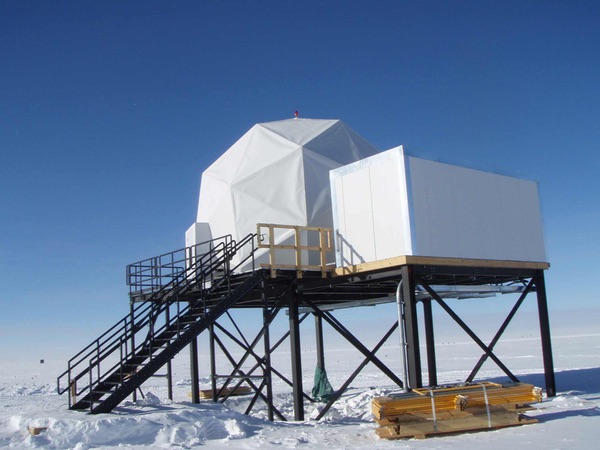 South Pole TDRSS Relay. (credit: US Antarctic Program) |
South Pole switchboard in the sky
Without north-south station keeping, TDRS-1’s inclination would increase between 0.75 and 1 degree per year. Due to the increasing inclination on the geosynchronous satellite, TDRS-1’s usefulness in the constellation was assessed as limited. During a 24-hour period, the satellite would swing in a figure-eight pattern above and below the equatorial belt, requiring satellite dishes to slew along the oscillating orbital track to transfer data.
| The ever-increasing orbital inclination also gave TDRS-1 a unique perspective not normally accessible from geosynchronous orbit: a view of the Earth’s poles. |
NASA engineers awaited the launch of TDRS-B to even out some of the issues caused by TDRS-1’s inclination. But with the investigation of the IUS problem throughout 1983 and 1984, the TDRS-B launch slipped until early 1986—aboard the ill-fated Challenger. The need for TDRS-1 and TDRS-B replacements was so great, the shuttle program’s return-to-flight mission in 1988 carried a TDRS. Future TDRS flights were aboard STS-29 (TDRS-4, 1989), STS-43 (TDRS-5, 1991), STS-54 (TDRS-6, 1993), and STS-70 (TDRS-7, 1995).9 With the launch of TDRS-4 and its positioning as the “East” relay, the first satellite was relegated to serving as a backup.
The ever-increasing orbital inclination also gave TDRS-1 a unique perspective not normally accessible from geosynchronous orbit: a view of the Earth’s poles. With communication links to Antarctica at a premium, the highly inclined TDRS-1 connected Amundsen–Scott South Pole Station to the continental US via the “South Pole TDRSS Relay.” From 1998 to 2009, TDRS-1 connected polar scientists for around five hours a day via high-rate (275 megabits per second) and low-rate (5 megabits per second) connections for data transfer, Internet connections, and telephone calls.
On April 28, 1999, the first phone call took place between personnel at the north and the south poles, via TDRS-1. The 45-minute phone call is listed in the Guinness Book of World Records as the “first pole-to-pole call.” The TDRS relay was also used for telemedicine conferences, connecting Dr. Jerri Nielsen with doctors in the US for treatment of breast cancer during her 1998–1999 winter-over in Antarctica.
In late 2009, the final traveling wave tube amplifier (TWTA) on TDRS-1 failed. After the satellite reached its final graveyard orbit above the GEO belt, it was retired on June 27, 2010, after 27 years of service to the US space program.10 It was a fitting end to “The Queen of the Fleet.”
Dramatis personae (circa 2017)
Today, the TDRSS constellation is in routine operations, unlike the “cowboy ops” of the 1980s. The network consists of seven active satellites, with another expected in 2017, and still provides worldwide data and communications coverage. Only two first-generation satellites launched aboard the Space Shuttle are still active, TDRS-6 and -7. The “inconceivable” mission of connective relay to the South Pole is now regularly serviced by TDRS-6.
The GEODSS sky-spotters in Socorro are still around. According to a 2016 news article about Detachment 1, GEODSS continues to provide data to “[help] decision-makers identify threats both natural and man-made, predict or detect threatening actions, find lost objects, maintain element set data, and help leaders take protective actions.”11 And, presumably, rescue wayward satellites too.
In summarizing GEODSS mission at Soccoro, site commander Capt. Erin Salinas stated, “Combined with the three other [space surveillance] locations, we are the premiere space surveillance squadron. No other squadron comes close.”
I wonder if she ever heard about the tale of TDRS-1 and her system’s participation in saving it. With such a prideful statement, perhaps she already had.
Endnotes
- Froehlich, Walter. “The Tracking & Data Relay Satellite System. The New Space Network.” NASA EP 251, 1989, 13
- NASA. Tracking and Data Relay Satellite (TDRS). February 24, 2017.
- McCoy, K. and J.L. Vaniman. “IUS/SRM-2 Nozzle Thermal Assessment.” DTIC AD-P004 974.
- Evans, Ben. Tragedy and Triumph in Orbit: The Eighties and Early Nineties, Springer-Praxis, 2012.
- Bruck, R. GEODSS Overview. September 2014.
- MIT Lincoln Laboratories. “LINEAR/Experimental Test Site.”
- Kessler, Donald J. “A Partial History of Orbital Debris: A Personal View.”
- Lewis, Richard. The Voyages of Columbia: The First True Spaceship. Columbia University Press, 1984, 201-202.
- NASA, “JSC Almanac.” June 1993.
- Buck, Joshua. “NASA Retires First Data Relay Satellite After Stellar Career.” NASA Release 10-154.
- Smith, Dave. “Bringing actionable awareness to the fight.” 21st Space Wing Public Affairs, October 4, 2016.
